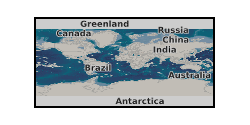Apatite
Type of resources
Topics
Keywords
Contact for the resource
Provided by
Years
Formats
Update frequencies
-

Dihedral angle data and bulk rock P2O5 concentrations for cumulates from the Skaergaard Intrusion of East Greenland. The data were used to constrain the thickness of the mushy layer at the point in the stratigraphic where apatite arrives as a liquidus phase. The work was published: Holness et al. (2017) Journal of Petrology, doi: 10.1093/petrology/egx040
-

TIMA images of samples from Mindola North, and Nchanga. TIMA images at Nchanga include Mindola Clastics and Upper and Lower orebodies. Identified minerals include quartz, microcline, phlogopite, muscovite, dolomite, chlorite, albite, calcite, chalcopyrite, carrollite, bornite, Co-pyrite, chalcocite, malachite and heterogenite. TIMA images from Mindola show dolomitic siltstones and impure dolostones. Chapters 4 and 5. Kelly, Jamie (2024) Dataset for thesis "Constraining Cu-(Co) mineralisation in sediment-hosted copper deposits using rutile, apatite, and carbonate geochronology". University of Southampton doi:10.5258/SOTON/D3219 [Dataset]
-

Trace element geochemistry, using Electron Microprobe Analyses, of rutile and apatite from the Zambian Copperbelt, includes standards, and accuracy and precision. Apatite grains from Arkose , Kitwe and Mindola Clastics Formations, Nchanga were analysed using a JEOL JXA-8530F Plus hyperprobe electron microprobe at the NHM, London. Spot locations were chosen away from any pits or inclusions. Most apatite crystals received two spots; one located close to the core and one close to the rim in order to assess compositional zoning and intra-grain heterogeneity. The elements P, Ca, F, Cl, Na, S, Sr, Fe, La, Ce, Mn, Si, Mg and Ti were measured. F, Sr, Cl, P and Ca were measured first in analytical sequence as suggested by Goldoff et al., (2012) to minimise time-dependent x-ray count variations. For rutile, 14 elements were measured across the 5 WDS detectors under the same operating conditions as for apatite. These elements were Si, Al, Mg, Ca, Ti, Nb, Zr, Cr, V, Fe, W, Sn, Ta and Mn.Three samples, of Arkose, from the Kitwe Formation, Nchanga, Zambia (NOP741-16p, NOP741-17p 282 Appendix B and NOP741-19p) were analysed. Where possible, spots were chosen on the same rutile grains as laser ablation and away from any debris. For geological setting of individual samples see Appendix A ; Kelly, Jamie (2024) Thesis "Constraining Cu-(Co) mineralisation in sediment-hosted copper deposits using rutile, apatite, and carbonate geochronology". University of Southampton doi:10.5258/SOTON/D3219 [Dataset]
-

U-Pb isotope ratio data set for numerous phosphate (apatite) grains in two thin section samples of the LL5 S4-6 Chelyabinsk meteorite. One section is of the S4-6 light lithology, and another of the S5-6 dark lithology. Samples analysed were section ‘A' (light lithology) and section ‘B’ (dark lithology) of Chelyabinsk, both from the Open University School of Physical Sciences sample collection. The results demonstrate variability in degree of Pb-loss during collisional reheating from pristine versus damaged apatite crystal domains. These results are reported for a meteorite fall which originally happened near Chelyabinsk in Russia. The results otherwise have no geographic location, as this is a sample of an asteroid. All measurements were made in December 2020. These data were collected using Secondary Ionisation Mass Spectrometry (SIMS) with a CAMECA IMS 1280 at the Institute of Geology and Geophysics, Chinese Academy of Sciences (IGGCAS). The thin sections were polished with colloidal silica, cleaned, and coated with gold prior to analysis. Microtextural information was obtained prior to analysis using a combination of back-scatter-electron, cathodoluminescence, and electron-back-scatter-diffraction analysis. Data were obtained to test hypotheses relating to the competition between macro-to-meso-scale thermally-driven variation in Pb-loss rates versus microscale variation driven by grain-specific features, e.g., fracture networks. An article describing and discussing these results, including further methodological steps in their collection and processing, is due for publication. This information is currently available in preprint form on arXiv: https://arxiv.org/abs/2112.06038
 NERC Data Catalogue Service
NERC Data Catalogue Service